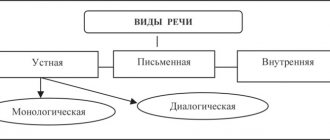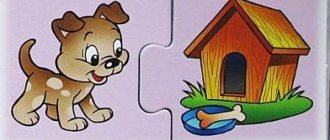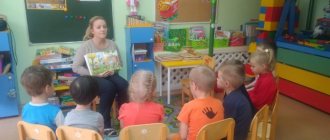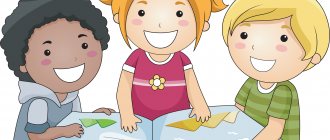Development of speech creativity in preschool children article on speech development (senior group)
Upyreva Nadezhda Viktorovna,
Teacher of GBDOU kindergarten No. 17
Krasnogvardeisky district of St. Petersburg
Development of speech creativity in preschool children
Preschool age is a period of active acquisition by a child of spoken language, the formation and development of all aspects of speech: phonetic, lexical, grammatical. Full command of the native language in preschool childhood is a necessary condition for solving the problems of mental, aesthetic, and moral education of children.
The Federal State Educational Standard for Education indicates the need to include the development of speech creativity of preschoolers in the content of the educational field “Speech Development”. The “Law on Education of the Russian Federation” states that preschool education should be aimed at the formation of a general culture, the development of physical, intellectual, moral, aesthetic and personal qualities, and the formation of prerequisites for the educational activities of preschool children.
Speech creativity is the independent activity of children in constructing coherent statements caused by the perception of works of art, stimulating children’s use of a variety of expressive language means, conveying the child’s impressions of artistic information.
The huge role of creativity is determined by the fact that it opens up new values for the child of cognition, transformation, experience, which enrich his world, contribute to the manifestation of the creative qualities of the individual, which corresponds to the principles of the Federal State Educational Standard (supporting children’s initiative in various types of activities; formation of cognitive interests and cognitive actions of the child in various types of activities). Exploring the surrounding reality through creative activity, the child shows an emotional and aesthetic attitude towards it, feels like an “active figure”, constantly discovering something new for himself and declaring new things about himself (L.A. Wenger).
The following types of speech creativity are distinguished:
- Retelling.
- Writing based on plot pictures and large paintings.
- Compiling stories and fairy tales from personal experience.
- Compiling narrative narratives based on topics.
The ability for speech creativity is formed in older preschool age, when children have a stock of knowledge about the world around them, the active side of speech, imaginative thinking and creative imagination are sufficiently developed.
To develop children's speech creativity, it is necessary to work to increase the levels of verbal sociability, coherent speech, vocabulary, grammatical structure of speech, the sound side of speech, and practical awareness of the elements of language. Educational tasks are solved during routine moments, in the joint activities of children with the teacher, and in the independent activities of children. Well-developed material is used, and it is also necessary to create a large number of new game situations.
It is necessary to organize the child’s speech activity in such a way that it is of a playful and entertaining nature, because only in this way can the child develop the ability to accurately and figuratively express his thoughts and feelings in the spoken word.
An important task of parents and teachers is to create favorable conditions for each child: early physical development; sensory experience and motor skills; an environment that stimulates and advances development; the need for maximum effort, i.e. gradual shifting of the “ceiling” of one’s capabilities higher and higher; a comfortable psychological environment, including recognition of the value of the child’s personality, absence of external assessment, understanding, empathy; unobtrusive, intelligent, friendly help from adults; providing the child with great freedom in choosing activities; availability of free time.
Table 1 - Targets
| Targets | Specification with age and topic | An example of manifestation in action and in speech of a child |
| The child masters the basic cultural methods of activity, shows initiative and independence in various types of activities - play, communication, cognitive and research activities, is able to choose his own occupation and participants in joint activities. | The child masters the basic cultural methods of activity. | The child shows initiative and independence in various types of speech creative activities. |
| The child has a positive attitude towards the world, towards different types of work, other people and himself. | The child shows interest in communication, play, research activities, and speech creativity. | The child is able to express in the story his own attitude to what is happening, to the object of description, mood, emotional reaction. |
| The child has a developed imagination, which is realized in various types of activities, and, above all, in play. The child masters different forms and types of play, distinguishes between conventional and real situations, and knows how to obey different rules. | The child has a creative imagination, which manifests itself in speech creativity. | The child has a developed imagination, which is realized in various types of activities and, above all, in play. |
| The child has a fairly good command of oral speech, can express his thoughts and desires, can use speech to express his thoughts, feelings and desires, and construct a speech statement in a communication situation. | The child has developed all types of speech: coherent, dialogical, monologue. | In play situations, the child masters storytelling techniques with transformation, with replacement of the interlocutor or point of view (narration from the point of view of a bird, animal, object, fairy-tale character). |
| The child shows curiosity, asks questions to adults and peers, is interested in cause-and-effect relationships, and tries to independently come up with explanations for natural phenomena and people’s actions. Has basic knowledge about himself, about the natural and social world in which he lives; familiar with works of children's literature. The child is capable of making his own decisions, relying on his knowledge and skills in various activities. | The child willingly communicates with peers and adults, has communicative competence, is able to carry on a conversation, and develop dialogue with peers and adults. | A child is able to compose a story (story, fairy tale) on an independently proposed topic, compose a detailed and short story on one topic, compose a fairy tale based on one existing sentence that should be included in it, compose a story based on a real event. |
Contents of the educational process
To solve the problem of speech creativity, it is necessary to supplement the main content of the educational process, means of teaching, and upbringing.
Table 2 - Contents of the educational process
| Activities | IN GCD | Outside GCD | What is it aimed at? |
| 1.Game activity. | Role-playing games: “Visiting Winnie the Pooh”, “The Cook”, “Traffic Light”, “At the Bus Stop”, “On the contrary”; speech games “Magic Circle”, “Carousel”, “Complete the Sentence”; game with the rules “Forest Stops”; multimedia games “Funny composition”, “Guessing game”, “Composing from funny pictures”. | Role-playing games: “Funny Cars”, “Journey”, “Stop on Demand”; role-playing games “Masks”, “Playing a Fairy Tale”; game with the rules “Living Words”; board and printed games “Shop”, “Write a story”, “Understand me”; role-playing games “Family of Dwarfs”, “Let’s go for a visit”. | To develop creative imagination, which is realized in various types of activities and, above all, in play. |
| 2. Cognitive activity. | Experiments with water, sand, clay, sunlight; observation of plants and animals; research activity “What is made of what?”; research projects. | Observations of living and inanimate nature during walks; intellectual competitions; conferences on project activities with the participation of parents. | For the child’s mastery of cultural ways of activity: thinking, cognition, problem solving, obtaining information. |
| 3. Problem-based communication. | Conversations and examination of illustrations in books, discussion of the content of a literary work, composing fairy tales using the methods of J. Rodari (“Grammar of Fantasy”). | Discussing fairy tales read at home with parents; joint project activities with parents. | On the formation of communication skills, on the development of coherent, dialogical, monologue speech, which underlie speech creativity. |
| 4.Social creativity | Social and educational projects “Who are the volunteers”; collective creative activity “Creating a collage”. | Joint events with volunteers; social partnership with the library, school, and additional education organizations. | To develop initiative and independence during joint activities with adults. |
| Excursions to the library, to the local history museum, excursions to a painting exhibition, to the cosmonautics museum, to the park. | To instill in a child a value-based attitude towards cultural values and traditions. |
Techniques and methods for developing speech creativity in preschool children
In kindergarten, a wide arsenal of means is used - special speech classes, didactic games, folk games, dramatization games, speech and problem situations, “director’s games”, quizzes, ethical conversations, in which the main attention is paid to the development of the communicative function of speech.
The creative development of a child is possible only with positive motivation. The most powerful motive for a child is play. It is the game that makes the process of completing tasks and solving problem situations interesting, exciting, and stimulating a creative approach. It is necessary to organize the child’s speech activity in such a way that it is of a playful and entertaining nature, because only in this way can the child develop the ability to accurately and figuratively express his thoughts and feelings in the spoken word.
Pay special attention to an individual and differentiated approach to children. Before starting work on composing stories and fairy tales, it is necessary to replenish children’s vocabulary with adjectives, verbs, adverbs, teach them to compare, and select epithets.
A number of speech games can be used for this purpose. For example, “Word on the palm of your hand (on the ceiling, on a tree, in water...)”, “Beautiful words (prickly, sweet, etc.)”, “Find out by description”, “Yes - no”, “Magic wand” , “What does this look like?”, “Name the same toy differently,” “Name it differently (fairy tale, poem, story).”
You can engage in word creation individually, in subgroups, or all together, creating collective fairy tales and poems.
To stimulate the development of speech creativity, it is necessary to shape children’s search activity through questions: “Why?”, “What will happen if...?” Using the possibilities of vocabulary work, a system of exercises to enrich the vocabulary.
- Selection of definitions and epithets (what types of mothers are there?)
- Recognizing objects by epithets (juicy, ripe, velvety - what is it?)
- Selection of actions for the subject (how can you play?)
- Selecting an object for action (What is the dog doing?)
- Selection of circumstances.
- Selection of synonyms (big, huge...)
- Finding the missing words (the janitor took a broom, he...)
- Distribution and addition of sentences (children go, where? Why?)
- Making sentences with a certain word.
- Active use in the educational process of works of Russian folk art: tongue twisters, nursery rhymes, proverbs, sayings, etc.
Working methods and techniques:
- Modeling using geometric shapes, colored circles, chart cards;
- Fantastic transformation of literary text
- Transfer of an individual hero to other conditions;
- Combining characters from different literary works;
- Use of Propp's maps;
- Changing the sequence of events in a literary work;
- Narrating a work on behalf of a literary character;
- Changing the characteristic features of literary characters - using TRIZ technology “good-bad” (“About the good Baba Yaga and the evil girl”, “About the evil carrot and good honey”);
- Sound replacement (“Doors and Beasts”);
- inventing the beginning, continuation and end of a fairy tale;
- writing fairy tales using several techniques, coming up with a “salad from fairy tales.”
Children are required to be able to come up with a plot, a course of events,
climax and denouement. The ability to select individual facts, introduce elements of fantasy into them and compose a creative story. A creative story is a story that children come up with themselves, because there is an element of creativity in any children's story.
The development of creative abilities will awaken the hidden potential, reserves, originality and talent inherent in any child. However, the ability to create, including speech creative ability, will develop most successfully only if its development is promptly provided with appropriate incentives and optimal conditions of the environment in which the child is located.
List of used literature:
1. Arushanova A.G., Ivankova R.A., Rychagova E.S. Developmental communication
communication with children 2-3 years old: Sfera, 2013, 96 p.
2. Glukhov V.P. Formation of coherent speech in preschool children with
general underdevelopment of speech. - M.: Library of a practicing speech therapist, 2002 - 230 p.
3. Kozachenko I.I. Using didactic syncwine in working with
preschoolers. - Department of Preschool Educational Institution No. 8, 2015
4.N.I.Levshina, O.V.Zakharova, Yu.A.Prokopenko, T.G.Rezvanova. Development
speech creativity of preschool children through Lego construction.-
Preschool pedagogy, 2011 No. 8
5. Ushakova O.S. Speech development of preschoolers. - M.: Institute Publishing House
Psychotherapy, 2001 - 256 s.
6.Arushanova A.G. Speech and verbal communication of children: A book for kindergarten teachers. - M.: Mozaika-Sintez, 2000. - 272 p.
7. Nishcheva N.V. Educational fairy tales: A series of classes on developing the lexical composition of the language, improving the grammatical structure of speech, and developing coherent speech in preschool children - an educational and methodological manual-summary. - St. Petersburg: Childhood-press, 2002. — 47 s
8.Program of education and training in kindergarten/Ed. M.A. Vasilyeva, V.V. Gerbova, T.S. Komarova - M.: Mozaika-Sintez, 2007 - P. 130 - 132.
9. Speech development in preschool children / Ed. F. Sokhina. - M.: Education, 2001.
10.Say it differently: Speech games, exercises, situations, scenarios / Ed. O.S. Ushakova. - Samara, 2001. - 10 p.
Definition of speech creativity in psychological and pedagogical literature
According to E.B. Tannikova, speech is a historically established form of communication between people through linguistic structures created on the basis of certain rules.
S.V. Alabuzheva believes that speech accompanies almost all types of children’s activities. At the same time, she herself is enriched and improved in the process of the child’s activities. The more developed a person’s speech, the easier it is for him to express his thoughts and explore the world around him, establish meaningful relationships with adults, control his own behavior and develop his own personality.
According to A.M. Borodich, speech consists of the processes of perception and generation of messages in order to fully communicate. Also, messages can be received and analyzed in order to regulate their behavior and monitor their activities.
MM. Alekseeva studies speech as a universal tool of communication, as a very complex and special form of organizing activity, in which at least two subjects take part: one produces statements, and the other perceives them.
T.I. Grizik and L.E. Timoshchuk consider speech as a speech activity that acts as an activity act or in a type of speech activity that is included in a certain non-speech activity.





